
LED light roundup #10
Review date: 7 October 2002.Last modified 03-Dec-2011.
The incandescent globe's days are numbered. The number's still pretty large, in my opinion, but more and more lights that use other technologies - LEDs in particular - are coming out.
Here's the latest batch to cross my desk.
All of the good names were taken
Dorcy have a mildly wisible name, but they produce some perfectly acceptable low-cost LED flashlights. No fancy microprocessor control or ultra-bright output, but the price is right; here in Australia, according to one of my readers, Kmart sell at least one model of Dorcy light for $AU22.99.
This is that light, the waterproof model 41-2498. Dorcy sent me this one direct; I haven't hunted one up at Kmart, whose web site doesn't list them.
The plot, however, thickens. The 41-2498 Dorcy light is actually the same product as the LedCorp Turtlelite, which I reviewed rather a while ago here. The Dorcy light I got for review has a yellow plastic body instead of the military green of the LedCorp-branded light, but that's it for the differences; it's the same moderately waterproof (the pushbutton switch will be constantly pushed by the pressure of more than a few feet of water), single-LED, spot-beam, fold-out-lanyard-loop, four-AA-cell-power design. Dorcy include batteries with all of their LED lights.
The Turtlelite lists for $US19.95, which is more than $AU36, as I write this. The Dorcy version is clearly better value; a US reader tells me he found one at Wal-Mart for less than $US9.
As with the LEDCorp-branded light, this one's got a profiled LED in a conventional flashlight reflector, which gives it a non-adjustable spot beam. The spot is brighter than the light from most LED flashlights, especially at moderate-to-long range, but that's just because of its tight focus; the single LED doesn't actually put out very much light, despite being driven at more than 70 milliamps (mA, thousandths of an amp) by fresh batteries.
70mA-plus is definitely on the high side for a normal 5mm white LED, but most of the time this LED won't be driven that hard, because most of the time the flashlight won't have fresh batteries in it.
As with all other LED flashlights, this one works very well from less-than-new batteries, because the light colour doesn't drop away towards useless infra-red as the batteries age. Single-LED flashlights like this one can reasonably be expected to output better-than-nothing light even after they've been left on for a straight month. Don't expect alien-signalling beam power from almost-dead batteries, but you'll still be able to use the light to read a map, assuming your night vision's not too awful.
From half-dead batteries, this flashlight won't be beating its LED to death, but will still output generally useful light. Take that into account, and a lamp life sufficient for several years of continuous use seems plausible enough, despite the hard life the lamp has from new AAs.
And, heck, if it dies you can always buy another one. It's not as if this thing costs a million bucks.
This wasn't the only light Dorcy sent me, and it wasn't the only one that LEDCorp resell, either.
This Dorcy 41-2750 light's blue-anodised and has "Dorcy" stamped on the end instead of "LEDCORP" engraved there, but it's otherwise exactly the same as LEDCorp's black-anodised "Our Best Aluminum Flashlight", which I also reviewed here. The LEDCorp version lists for $US34.95; you can bet the Dorcy version'll be cheaper.
This light's focussable, and you can unscrew the reflector assembly altogether if you want to use it as a candle, or just peer more closely at the profiled LED. The LED's a little off-centre and can't be bent into a better position, so this light's tight beam focus isn't as good as the LEDCorp version I got; I don't know what kind of quality control you can expect from the Dorcy branded lights.
Again, this LED's driven hard from fresh batteries, but ought to last OK as long as you aren't extraordinarily keen on replacing the batteries whenever the light dims a bit.
Here's the aluminium flashlight's battery cartridge, which is reasonably easy to load with four AAs, and very easy to load into the flashlight.
If you want maximum brightness and minimum lamp life, you can load the cartridge with four lithium AA cells. Fresh lithium AAs deliver around 1.8 volts per cell when unloaded (versus about 1.6 volts for a brand new alkaline), and will deliver a higher voltage under load as well. For this reason, lithiums are commonly used by people who want maximum oomph from their flashlights. The down side is that running lamps at higher power levels isn't good for them. Use lithiums in your Mini Maglite and you'll replace bulbs more often than batteries.
Since the Dorcy lights' LEDs are already begging for mercy when powered by four fresh alkalines, I'd give the lithiums a miss if I were you.
Dorcy weren't done. They also sent me this.
This is the 41-2494, another single-LED light running from four cells, but now with four AAAs in a double-barrel configuration, a normal curved-lens LED for a broad pool of light instead of a spot beam, a neat little switch on the back, and a pocket/belt clip.
This LED hasn't been ground down for a fairly even all-round radiation pattern, so it throws almost all of its light forwards. This makes the 41-2494's reflector pretty much decorative; it catches a little light that escapes the LED to the sides, but it really makes not much difference to anything.
Again, this LED's working hard from fresh cells; again, that ought not to matter unless you change the batteries rather too often.
This isn't a premium product, but it's easy to get batteries in and out, and the casing is decently splashproof and also seems reasonably tough. This thing's small enough to be used as a pocket light...
...and the tail-mounted switch makes you feel all dangerous and tactical.
The 41-2494 feels cheesier than the other two Dorcy lights. It rattles a bit, and sometimes it loses contact because of the rattle. I found that taking the lamp assembly off, jiggling the batteries a bit and reassembling the light pretty much cured the dodgy-contact problem. Since this is sure to be another cheapo light, and it's slim enough to carry in your pants pocket without horrible discomfort, the rattle is entirely acceptable.
Dorcy claim 200 hours of battery life for the two AA-cell lights, but 600 hours for this AAA-cell model. That doesn't make a whole lot of sense, since AAAs have somewhat less than half the capacity of AAs, and also have lower current delivery capacity - you get less of their rated capacity into a given load.
The lamp in the AAA-cell light draws about the same current for a given voltage as the lamps in the AA-cell models, so I wouldn't be surprised if the AAA-cell light had about 40% of the run time of the larger lights.
Mind you, even the AAA light probably will give you a faint night-light glow after 600 straight hours; it's likely to be useless for anything more demanding than reading a book one word at a time, but anything's better than nothing.
Here, for your delectation, are some beam-shot pictures, taken with my current digital camera at ISO 100, F4.0, with white balance set to regard the blue-white light of a typical white LED as pure white. The target is a piece of A3 paper, long side horizontal, set up to pretty much fill the frame; the flashlights are held 40cm from this target.
This is the output from the waterproof model 41-2498 light, with a 1/20th second exposure. It may not look like much, but it's a pretty good spot beam; with reasonably fresh batteries, you can easily use this light at night to see things at the top of a telegraph pole. There's enough spill around the spot to make the light useful for seeing what you're about to walk on, too, but you really need a broader beam to do that properly.
The aluminium Dorcy flashlight can be focussed down to a spot about as good as the waterproof light's, but it can also deliver wide-beam output - this isn't its broadest setting.
A wider beam means less light per unit area, of course; the above picture has a 1/5th second exposure. At 1/20th, there's not much to see.
This light is fine for seeing the path in front of your feet on its wide setting, but its useful range at that setting is miserable.
Here, for comparison, is a 1/5th second exposure of the AAA-cell Dorcy light's output. There's actually about the same amount of light, but it's more evenly distributed; this is a classic white-LED-flashlight output pattern. Fine for finding your way around, but not much use for seeing anything outside spitting distance.
All of the Dorcy strike me as excellent value for money (well, assuming the aluminium and AAA models aren't way more expensive than the waterproof one), provided you don't need a whole lot of light. The AAA-cell light's a neat little thing, the waterproof one's very hard to kill, and the aluminium light feels better than you'd expect, for the money.
But they're all only single-LED lights. A similar sized and cheaper flashlight with an incandescent bulb will massively beat them for brightness. The incandescent light will deliver ugly yellow light that doesn't seem as bright per watt, but it'll still win easily, while its batteries last.
Some people have used the aluminium Dorcy lights' sturdy body as a housing for seriously bright modifications, but that's the only way you'll get impressive output from these things.
A single-LED flashlight has more than enough output for many ordinary household lighting tasks, though. If you like the idea of being able to use your batteries until they're really used up, LED lights beat the heck out of incandescent. And the price should be right for these ones.
Your partially-plastic PAL
You are looking at a classic LED light. The PALight has been around for a couple of years now, and has been revised a few times, but it's still a distinctly different animal from every other flashlight. And it's darn handy.
This one's the top-of-range "Survival" model, which The LED Light (who supplied the light to me) sell for a mere $US17.50. This one's got a white LED; there are red, green and blue versions as well.
The PALight's first unusual feature is that it runs from a nine volt battery, which dictates the stubby rectangular shape of the light.
The two halves of the PALight's synthetic-rubber-armoured case are held together with a neat little clip, which you undo by pinching it. It ought never to let go as a result of abuse - well, not unless the abuse is sufficient to break the whole light - but it's quite easy to remove by hand, without tools.
Inside, all you can see is the (included) 9V battery, plugged into a standard snap fitting. The PALight's electronics are all in a sealed compartment at the front. The light's not waterproof, but it's highly water resistant; no amount of rain should be able to drown it.
The second unusual PALight feature is that the thing never turns off, unless its battery is dead or missing. There's an ultra-low-level glow all the time - which is why the light's lens, in the glamour shot above, looks blue.
The always-on mode is about bright enough for someone with OK night vision to read a coin-sized piece of a map; its purpose is to show you where the light is, not to show you where you're going. Press the rubber-covered button on the Survival PALight once and you get a low brightness mode; press it again and you get high brightness; press it a third time and the light goes back to always-on, but with regular attention-getting high brightness pulses; press the button once more and you're back in standby mode. There are cheaper PALights that lack the low brightness and pulse modes.
In always-on mode, the PALight draws less than 0.1mA. So you'd expect an unremarkable alkaline 9V battery with about half-amp-hour capacity to last more than a year.
It'll actually last a lot longer, though. The manufacturers claim a battery will last "over 2 years" with the light in always-on mode, and that actually seems plausible enough to me. That's because the PALight I tested worked surprisingly well at very low input voltages, which is what it'll get from a really worn out battery.
Hooked up to my bench supply and running at a level nine volts, the PALight drew 6mA in low brightness mode, and a hefty 78mA in high brightness mode - obviously, substantial energy's being wasted by the LED controller in this situation, because there's no way that LED's consuming seven tenths of a watt.
When I wound the power supply down to a mere 2.8 volts, though, the always-on mode was still a visible glimmer, and low brightness mode worked as well - though at only 0.2mA current draw, giving a much dimmer light than the flashlight had managed at 9V. High power and pulse modes didn't work at all. But a nine volt battery that can only deliver 2.8 volts into a 0.2mA load is, for all normal intents and purposes, dead flat. A 9V that won't give you a glimmer of life from, say, a transistor radio, will thus actually give you useable output from a PALight.
A lithium 9V battery (lithium 9V batteries actually deliver nine volts - they don't have the over-voltage problem of lithium AAs) has more than twice the capacity of an alkaline one; I'd seriously consider one of those as the second battery for a PALight, after the included alkaline 9V finally dies.
UPDATE: As of the end of April 2004 (almost 19 months after I first wrote this review), I officially pronounce the battery that came with my review PALight dead. It's still good for about 4.5 volts, which means the always-on glow is still fine, and the low brightness mode still works (dimly), and the pulse mode works too, though also dimly. High power ain't happenin', though, and the light is not very useful.
So the two year battery life claim is perfectly plausible - this light actually did get used from time to time, and I don't know how long it had been sitting on the shelf before it was sent to me, so 19 months ain't bad. Someone who uses their PALight semi-regularly and wants high brightness mode to work well may find themselves changing batteries once or twice a year. Fair enough.
The lens on the front of the PALight gives it a quite tight beam, so it's not the best thing for finding your way down a treacherous path. But if you want decent brightness at medium range from a single LED, you need a narrow beam.
This is the PALight's output on the low setting, photographed with a 1/5th second exposure...
...and this is the high-setting output, at 1/20th. It's easily up there with the output from the tight-beam Dorcy lights, but the PALight's much more compact.
Compared with pretty much any incandescent-bulb flashlight, the PALight is still pretty dim. But it's genuinely pocket-sized, the always-on feature is really handy for anybody who reckons they're likely to have to find their flashlight in the dark, and the Survival model's extra features are useful. And the thing's really very reasonably priced.
The PALight has the utilitarian, no-nonsense look-and-feel of a good piece of army-issue equipment, and it does what it sets out to do. I like it a lot.
The LED Light also, by the way, stock the Sure White PALight, which has a white LED and only the always-on and high-power features, but with a 30 minute auto-power-off feature to stop the battery going flat if the light's turned on by accident. The Sure White is only $US15.50.
Sci-fi lighting
This sleek little item is an Inova X5. It's about 119 by 20mm in size (4.7 by 0.8 inches), so it's pocketable, but you're not going to forget you're carrying it. For its size, though, this is a seriously bright light.
The X5 I got to look at isn't quite the current model - The LED Light stock that, for $US49.95 (on special for $US46.95, as I write this). This previous-model X5 is rather good; the newer version looks to be even better.
The X5's made from aluminium alloy (plain bare-metal anodised finish, or black anodised), and is as solid as a rock. Its lamp has five 5mm LEDs, in your choice of white, red or blue. I got a plain-alloy, blue-LED X5 to play with.
The Inova lamp assembly has a simple spring-loaded peg sticking out of the back of it that stops the batteries rattling, and serves as a switch as well; half-unscrew the lamp end of the light and the X5 turns on. The light runs from a pair of three volt 123-type lithium cells, as used in various compact high-powered "tactical" lights.
If a guy wearing body armour is pointing a gun at you, and if that gun has a flashlight clipped under its barrel, then the light is likely to have 123s in it. More prosaically, 123s are also used by lots of cameras.
123s have the advantage that they're small (34.5 by 17mm) and have impressive capacity - 1.3 to 1.4 amp-hours, into a small load. They've got reasonable tolerance for high loads, too; you can get about a watt out of a 123 without beating it to death. So a light powered by three of them can have a three watt bulb and still manage around three hours of decently bright run time.
Many lights work the 123s rather harder than that, and deliver run times from 90 minutes down to a mere 20 minutes or so. The really low-run-time monster lights aren't normal flashlights; they're meant for intermittent use, for victim-dazzling and target-identification purposes.
The X5 isn't that ferocious. It hauls a couple of fresh 123s down to about 5.8V and draws about 280mA in the process, so you're talking a bit more than 1.6 watts peak draw - eight tenths of a watt per cell. Fortunately, the LEDs aren't eating all of that; if they were, then they'd be driven at something like 325 milliwatts each, which is quite seriously steep. Normal running power for high intensity 5mm LEDs without special cooling is around 100 milliwatts.
This light, like most LED flashlights, is a simple resistor-fed design; the LEDs are in series with a current-limiting resistor. The LEDs in the X5 are all wired in parallel and each have their own little resistor; the thick end of half of the light's power is probably being wasted as heat by those resistors, when the batteries are fresh.
Anyway, the X5's meant to have more than a 20 hour battery life. That's believable. Once again, most of that life will be at reduced brightness, but it won't be as bad as it usually is for LED lights.
The reason for this is that the discharge curve for a 123 cell (see Energizer's PDF-format datasheet for their 123s here, for instance) is pretty flat. When 123s are used in flashlights instead of cameras they don't necessarily get breathing space between discharge pulses, but then again, the X5 doesn't work its 123s as hard as a camera does when it's charging its flash. What all this means is that the X5's batteries, at normal temperatures, should manage better than 2.5 loaded volts per cell (5 volts for the pair) until they're almost 9/10ths discharged. Below that, the X5 should still do OK; in my tests the lamp delivered worthwhile light down to a miserable 3.25 volts, and was still plenty better than nothing at 2.8V.
At or close to its full power, the X5 is bright. This is its output at 1/20th...
...and this is 1/40th, with the blue channel less overexposed.
The quoted 120 foot "effective range" is rather optimistic if you ask me - if your eyes are adjusted to the dark then you'd probably be able to tell a human from a tree by X5-light at 120 feet, but that's about it. At half that range, though, the X5 does very well indeed, and it's a great walking-about light.
This blue one takes some getting used to; single-colour lights make everything look like an alien planet, and they're not much good for reading maps, because anything the same colour as the light will look white.
If that bothers you, of course, you can just get the white-LED version. If you do, though, you'll get a bit less light.
Coloured LEDs are more efficient than white ones, because white LEDs are actually a blue LED with a phosphor coating inside that passes some of the blue, and turns some of the rest of it into red and green to fill out the spectrum. That process eats a fair few photons, and makes white LEDs only about as efficient as a good halogen lamp.
The updated X5, which I haven't seen, has a stainless steel lamp-end (presumably because trauma to the softer end of the original all-aluminium X5 can eventually allow the recessed LEDs to be damaged), a push-button switch (now the tail of the light unscrews for battery replacement, not the nose), and a bigger hole for a lanyard in the tail (the X5 I checked out has a lanyard hole only about 3mm in diameter). And the new model also comes with a nylon holster; the one I got comes with batteries, but that's it.
If you need spare batteries, by the way, The LED Light will sell you some with your X5, but won't sell batteries alone. They charge $US5.50 per set of two 123s, which is a good price.
Here in Australia, off-brand 123s go for about $AU10 each from non-price-gouging retailers; that's about the same price as The LED Light charge for two. Brand name 123s with less than 10% more capacity than the cheapies are maybe $AU14 here; buy 123s from a pharmacy and you can pay a great deal more.
You can get 123s for a lot less if you shop around; job lots of 123s regularly sell on eBay for around $US2 per battery.
Multiply nominal voltage by amp-hours to get a watt-hour energy capacity figure and an alkaline AA looks to have about half as much energy in it as a 123, but 123s' flat discharge curve and compact size, plus the fact that they have the same very long shelf life as other lithium cells, makes them better value than you might think.
People are often a bit startled by the price of fancy LED flashlights; $US50-odd's more than a lot of people want to pay for a lousy little pocket light. Show them an X5, though, and anybody blessed with even a slight dose of gadget-appreciation will see where the money's going. Recommended.
Purpleness
I've reviewed at ultra-violet lights before (here, for instance), but not UV LEDs.
Here one is, in a Photon Micro-Light 3.
And here another one is, in a Streamlight Stylus 3.
I reviewed a Photon 3 here and a Stylus 3 here; except for the LEDs in the end, these variants are the same thing. But the UV LEDs make a big difference.
The Photon features the "Covert" LED surround, which extends around the LED lens so light can only escape forwards, and the Commie Nazis to your left and your right won't be alerted to your presence. You can get purple Photons without this feature, as well.
The LED Light sell Photon 3s with and without the Covert housing for $US19.50 and $US18.50, respectively; this purple Photon costs $US19.50, but there's also a deeper-UV version for $US43.
The LED Light sell regular Stylus 3s for $US17, but the UV version is $US60.
UV LEDs so far all seem to emit light at the longer end of the 315 to 400 nanometre (nm) ultraviolet A (UVA) band; 350nm UV LEDs apparently exist, but even 350nm isn't an especially short wavelength, and nobody seems to be building those ones into lights yet anyway.
The relatively long wavelength of these LEDs means they're quite safe. Shorter wavelength UVB and UVC light is what'll burn you; you can stare at a high-UVA nightclub blacklight all night and do yourself no harm. These lights are bright; pointing one at your eye for an extended period is no more sensible than staring at any other bright LED light. But you won't end up with UV-burned corneas as a result.
Both of these lights emit some light at longer wavelengths than 400nm, which means you can see when they're on. The Stylus looks very dim when it's not illuminating something UV-fluorescent, because only a little of its light makes it into the visible spectrum. Presumably, the "UV" Photons, as opposed to this purple model, look much the same as this Stylus; the purple Photon emits plenty of visible purple light as well as its UV. It's a rather more powerful light overall, with a much broader beam than the Stylus and obviously superior effectiveness at causing UV fluorescence.
Mind you, the Photon's a key-ring light. Whenever you use it at full power, you're wringing the necks of its two little 2016 cells; more about them in a moment. The AAAA cells that power the Stylus (I talk about those oddities more in my earlier review) will greatly outlast the Photon's batteries.
As normal for Photon 3s, the purple one lets you press the front of its single button for momentary, full-power operation, or the back of the button for other functions. Hold the back of the button down and the light cycles through high, medium and rather strobe-y low power, two flash rates, a Morse code SOS flash (that's a pretty perverse thing to do with a partially UV light if you ask me, but never mind), and an "auto off" mode that runs the light for about one and a quarter minutes, before running briefly at half power (the length of the half-power period indicates the battery state), and turning off again.
Press the back of the button for a moment and you turn on or off whatever one of these modes you've previously selected by holding it. It's a pretty impressive function set to access with just the one button.
The Stylus is a bit boring, in contrast. You press a button on the end of it for momentary operation, and screw the end-cap down to lock the light on. The UV Stylus also comes with a protective lightproof cap for its LED end, which you don't get with the regular Styli.
The purple Photon's packaging has UV-luminescent stripes printed on the cardboard that sits under the light; they're invisible until you press the Photon's button. This effect alone ought to be enough to sell quite a lot of these lights.
There are plenty of other glowy things around the average home. Anybody who's played with a black light, or spent sufficient time in appropriately lit clubs, will know what sorts of things will glow - various white cloth and paper items, security markings on currency, UV-luminous ink used for club pass-stamps, and so on.
It is also alleged that it's possible to spot dried urine and other, ah, bodily fluids, by using near-UV lights. I conducted a couple of experiments in this regard (whose details I will leave to your imagination, gentle reader), and had pretty much zero success.
I think, for these tasks, it helps to have shorter wavelength (higher energy) UV, which you won't get from any UV LED to date. It would appear that those big scary eye-protection-required UV light sources you see on TV are used for a reason.
Also, many surfaces on which bodily exudations end up (bedsheets, for instance) luminesce better than the exudations do, and drown them out.
Apparently you can use near-UV blacklights to spot some species of scorpion at night, since the beasties, helpfully, luminesce. I was, again, unsuccessful in my efforts to personally verify this.
I live in suburban Sydney, Australia. While I hasten to remind all potential visitors to this country that every stone in Australia has beneath it at least twenty spiders whose bite will immediately cause the victim's internal organs to liquefy and spray out of their navel, I regret to say that I don't think there are any scorpions near my house, luminous or not.
Purple LED lights like this Photon are nifty. They've got some flashlight value, and they make things glow odd colours as well. You can use them for counterfeit detection and mineral analysis and such, but they also make a perfectly good toy, and they're not unduly expensive.
UV LED lights with less visible output, like this Stylus, are more specialised and more expensive; the casual fiddler is likely to be a lot happier with a cheaper purple model. If you want an easy to use near-UV source that doesn't have a fragile glass tube in it, though, then one of these things may be just what you're looking for.
Lightwave 2100
I'm a fan of Lightwave LED flashlights. Innovative, they ain't; solid and useful and well priced for what you get, they are.
The Lightwave 2100 is a three-AA-cell, four-LED light in the same style as the Lightwave 3000 and 4000, which I previously reviewed here. That review also covers the Lightwave 2000, which is basically the same thing as the 2100, but has plain black plastic construction instead of the pleasing rubber-armoured design of the bigger Lightwaves, and comes with your choice of red, green or blue LEDs, as well as the regular white-LED version. It also comes with batteries; the other three Lightwaves don't.
The LED Light sell every Lightwave from 2000 to 4000. The 2000's $US27.50, and the 2100's $US34.95. For the extra money, the 2100 gives you the textured rubber coating, which I'd say is worth a couple of bucks. You also get a pushbutton switch, like the bigger Lightwaves, instead of the twist-the-end on/off mechanism of the 2000; twist-switches can't help but wear out their threads over time.
The 2100 comes apart like the bigger Lightwaves; loading batteries is easy, and the body and lamp are both solidly made and reasonably water-tight. The lamp has a raised lip around the LEDs, so you can drop it on its nose without scratching the lenses or punching any LEDs in.
Here's the 2100's output at 1/10th. It's perfectly good, for a four-LED light, and it only draws 150mA from fresh batteries, which means its LEDs aren't being punished, and its battery life should be very good.
The Lightwave 2100 feels better in your hand than the 2000, and has a better switch; I reckon that's worth the extra money, but you may think differently.
If you don't need a slim AA-cell light, a Lightwave 3000 (which takes three C cells) will give you much brighter output; The LED Light sell 3000s for only $US13.55 more than 2100s. The 3000 remains my favourite Lightwave, but there's nothing wrong with the 2100.
Bison 2C Sportslight
Bison's "Sportslights" aren't LED lights at all, so this two-C-cell model is a bit of a ring-in in this comparison. It's not just another boring plastic flashlight, though, and for the $US19.27 that The LED Light charge for it, it's not bad value.
For your money, you get batteries included, plus a neat slide-on lanyard, which firmly grips the light's body with a rubber ring rather than being knotted through a hole. The Sportslight is quite compact, it's water resistant, and it's a good looking thing. Its major claim to fame, though...
...is its unusual lamp assembly, which features a small bi-pin bulb nestled at the bottom of a steeply curved reflector, which in this picture is showing you several images of yours truly.
This is, apparently, an "Isoradiant (TM)" lamp design, intended to cure the usual incandescent-bulb-flashlight problem of a barely-lit hole in the middle of the beam at wide angle settings. The Sportslight's zoomable, by turning the black ring at the end of the lamp housing; you turn it on and off by clicking the whole lamp housing one way or the other. Clicking it back past its off position allows you to remove it altogether, to replace the bulb or use the light in "candle mode".
There's a spare bulb, but getting it out is a bit fiddly; you have to push hard to turn the clear plastic top of the switch assembly and line a hole in the top up over the well in which the spare bulb sits. Then the bulb just drops out. But if you get it half out and then lose your grip, I think you'll probably smash the bulb.
The Isoradiant idea works. Sort of.
The Bison definitely has an impressively wide maximum flood setting, and at that setting it doesn't have a black hole in the middle of its beam. It does, however, have a couple of brightly lit rings that move in and out as you focus; the light pool is still very uneven.
The Sportslight doesn't hit its batteries terribly hard. From two fresh C cells, it draws about 700mA; that's well over what an alkaline C cell wants to deliver and will thus considerably reduce the batteries' effective capacity, but you still ought to get more than five hours of service. You might even be able to stretch it to twelve hours before the light gets uselessly dim.
Here's the Bison's output at a medium zoom setting, with a 1/20th second exposure. It doesn't look quite this yellow in real life, because the camera's white balance is set to regard blue-white LED output as being white - but, like every other ordinary incandescent bulb, this one's light really does look very yellow indeed compared with white LED output.
As fairly cheap incandescent-bulb flashlights go, the Bison has a pleasingly even beam; by LED light standards it's nothing special, but it's focussable and respectably bright. It also seems pretty tough; it's an OK product for the money.
But it doesn't exactly exude quality. The switch mechanism feels cheesy, the end of the battery compartment has an odd metal liner that catches on the batteries as you remove them, and the spare bulb dispenser design is not good. And the Bison's Unique Selling Point isn't that big a deal. The Bison's light is more even than that from flashlights with reflectors of more conventional design, but it's still lousy compared with the lovely smooth pool of light from an LED.
Nice even LED lights with more than one LED in them can't be zoomed, of course; evenness of illumination isn't as important a feature as beam width flexibility, if you ask me.
Blue LED traffic baton
Another Weird Light.
This one's a simple enough thing. It's a traffic baton. One of those glowing sticks with which people instruct drivers to pull over, or turn here, or just Get Worried Now.
The most basic kind of traffic baton light has a single incandescent bulb with some kind of long thin diffuser over it - it might just be a tapering cone, or it might have some sort of light guide inside it to keep the illumination even. Either way, it'll waste considerable energy filtering the yellow light of the bulb into whatever colour the diffuser is, and it'll lose effectiveness rapidly as the batteries go flat and the bulb's hue slides down into the infrared.
Since traffic batons don't actually need to be terribly bright, they're a great application for coloured LEDs. You need a better light guide to get a few LEDs to evenly illuminate an inches-long baton, but you don't need coloured filters.
Hence, this.
It's only got three LEDs, but you'd think there were more. It lights up blue. It's bright enough that you can use it to find your way around the house at night, but that's obviously not its intended function.
The baton's about 370mm (14.5 inches) long, not counting the wrist-lanyard at the end, and it takes three C batteries. It only costs $US16.40 from The LED Light. There's a 3-LED red version as well, that's shorter because it only needs two C cells; there are also bigger 14-LED versions, one of which has all-red LEDs and the other of which has seven reds and seven greens, and lets you switch between them.
There may be all sorts of rules where you live about who is and isn't allowed to wave lights of particular colours around. You're reasonably likely to be able to avoid a talking-to if you aren't actually impersonating police, but don't come crying to me if your attempt to guide visitors to your Scout Hall to the right parking spaces lands you in the clink.
Legal details aside, this is a solid product. It's not built like a tank, but it ought to survive quite a bit of abuse, and its current consumption is reasonable. In full-on mode it draws about 260mA from fresh alkaline C cells, and should therefore be good for a couple of straight days of use before losing an unacceptable amount of brightness. The flashing mode's considerably easier on the batteries, though; I wouldn't be surprised if the baton still worked acceptably after a week of constant flashing on one set of batteries.
The baton's light guide is also fairly retroreflective - it bounces light back in the direction it came from quite well. So even when the baton's turned off, someone shining their headlights at you should be able to see you.
The baton's battery compartment has an O-ring seal, and the diffuser seems to be glued into the body all around, so it ought to be as waterproof as any light not actually meant for underwater use needs to be. The handle's plain plastic, but it's heavily ribbed and should thus be easy to firmly grip even in the rain.
A lot of nifty law-enforcement-ish toys are alarmingly expensive; they'd be useful and/or fun to have, but dropping big bucks on them only seems like a good idea to the chemically influenced.
These batons, on the other hand, are really quite cheap. You could buy a couple of them just to use as party toys. And if you do have to direct traffic at night in some official or semi-official capacity, these things'll get the job done, and won't run out of juice after the second hour.
For most people, this baton's not likely to be any use at all.
Some of them may buy one anyway.
Getting psychotic
Psycholights sell a variety of small LED lights aimed at the clubber/raver/just-like-glowing-dang-it crowd. Their mainstay "Psycho-Bright" lights, though, are perfectly good Photon II clones, and the price is right - only $US6.50 per light if you're buying one to four of them, plus $US3 for worldwide shipping.
For comparison, Photon IIs cost $US15.95 from the manufacturer.
If you want a lot of lights, no problem; Psycholights have a sliding price structure with its first price break ($US5.25, $US4 shipping) at five units. The Psycholights pricing rewards big purchasers with a unit price of only $US3.25 per light, for 200 to 250 units. Shipping costs for that many depend on your location.
For your money, you get a Photon II clone. Pushbutton momentary switch, little sliding plastic tab to lock the light on, four weeny screws to take it apart when you need to replace the two CR2016 lithium coin cells that power it.
The Psycho-Brights aren't quite up to Photon II standards - no fancy gold contacts or ultra-tough fibre-filled plastic casing, for instance - but they're still so close to the Photon II in design that Psycholights aren't selling them to US customers any more, apparently because of patent violation issues.
I got a full range of Psycho-Brights for review - blue, orange, white, green, red and purple. The purple's another somewhat-visible and somewhat-UV LED, like the purple Photon 3 I review above, but not as bright. In the picture above, the purple one's the light with the glowing UV-phosphorescent marble in front of it. Psycholights kindly also sent the marble, but they don't sell them. Nyaah.
All of these lights work fine - oddly enough, they feel just like a Photon II. The blue, green and white models are the favourites if you just want something bright; the orange model's pleasingly different but not terribly bright; the purple one works passably as a flashlight and also lights up UV-phosphorescent material, and the red one's reasonable...
...but, oddly enough, still uses two cells, like the other Psycho-Brights.
Red and amber key-ring lights usually have a single 2032 lithium coin cell in them, not a pair of the thinner 2016s, because red LEDs can run from a low enough voltage that one praying-for-death coin cell is sufficient. 2032s have more than twice as much capacity as 2016s, so there's good reason to buy a red key-ring light even if you don't want a red light for night-vision preservation or darkroom use or whatever.
Or not, if it's a red light with 2016s in it.
Ah, whaddayawant. They're cheap.
The battery change procedure for the Psycho-Brights isn't exactly intuitively obvious, but if you've got a little Phillips head driver for the four small screws, and if you pay attention to which way up the old batteries are and which way round the LED goes, it's not too hard. If you think you've got it wrong and made a light that never turns off, try just screwing the case halves back together. That ought to push the batteries and LED into the right arrangement and cause the switch to work properly again.
Psycholights sell batteries as well, by the way. They're off-brand "New Sun" cells, but they ought to work about as well as anybody else's coin cells for this application, and US buyers can get 24 of them for $US17.60 including shipping, which isn't a bad price. If you want to pay rather less, you hit the flea markets, but the difference really isn't likely to be very .
I've given up doing beam-shot pictures for key-ring lights. All but the very cruddiest ones, you see, are more than acceptably bright to start with (well, not counting the UV and IR variants), but will then dim enormously as the poor little lithium coin cells get beaten to death. The 20 to 30mA draw of a high intensity LED run at its specified power level is nothing much for a normal AA or even AAA cell to deliver, but coin cells are made for far lower current applications, like memory backup on motherboards. Anything that's up into the milliamps is a nasty load for these cells, and simple key-ring lights like these never have so much as a current limiting resistor betwixt batteries and LED; they rely on the substantial internal resistance of the coin cells to limit the current through the LED, and so commonly suck more than 50mA out of fresh cells. At that rate, the cells don't stay fresh for long.
Once again, though, the superb low-battery performance of LED lights comes to the rescue. It doesn't really matter that a key-ring light will dim noticeably in the first few minutes of use and greatly in the first hour, because even after the coin cells have been drained to effectively nothing, you'll still get enough light to find keyholes and avoid tripping over stuff on paths. It should be noted that lots of people who use these kinds of lights still find the output acceptable after more than a year of quite regular use.
This Psycho-Bright is a bit special. It's the "Rainbow" model, and it uses a triple-die LED with red, green and blue output. The dies are offset around the base of the plain 5mm LED lens, so the beam aim for each colour is different.
The Rainbow doesn't just glow in all three colours at once, either. It fades, pulses and flashes its three dies, separately and in combination, in a sequence that lasts about 12 seconds. It is, in other words, a key-ring-sized light for which the word "trippy" could have been invented.
The Rainbow isn't the first tiny-light to do this sort of thing. The Photon Rav'n (reviewed here) has the same basic concept, but it just cycles through red, green and blue, and is close to useless as an actual flashlight. It's not meant to be a flashlight, but it wouldn't hurt if it was.
The Rainbow's not what you'd call a mighty searchlight, but it is bright enough to use for flashlight purposes, assuming its batteries are reasonably fresh.
And if you wave the Rainbow around in front of a camera with the shutter open, you don't get a mere red-green-blue-red-green-blue light trail. Instead, you get...
...this.
The Rainbow, owing to its Photon-II-rip-off design, is another light that USAnians can't order from Psycholights. Everyone else, though, can order one to four Rainbows for $US10 each (plus $US3 for shipping), with price breaks as quantities increase. For 200 to 250 lights, the unit price is $US6, and shipping again depends on your location.
Assuming you're outside the USA and can thus actually buy one, the Rainbow is a seriously cool product. You can use it to find a keyhole or light your way up the steps, and you can also use it to impress the heck out of people to whom pretty lights appeal.
The regular Psycho-Brights are a good product at a good price; the Rainbow is really quite remarkable, especially considering its price.
I would not be surprised to learn that LRI, the makers of Photon Micro-Lights, hold the opinion that everyone associated with Psycholights is a piece of thieving scum. But if the clearly cloned nature of these things doesn't bother you, and if you're outside the States, I say buy 'em. They're great.
SolarCap Light Emitting Tile
The solar powered flashlight used to be just another Chindogu-ish joke list entry, but like helicopter ejection seats, the idea actually works if you add a couple of extra elements.
The thing you have to add to a solar light to make it useful is a power storage device, usually a battery. Sunlight charges the battery, and the lamp turns on when there isn't enough light for charging. The circuit to do just this much is simple enough, and as a result solar garden lights are now quite common things. Most of them use LED lamps, none of them are very bright, quite a lot of them handicap themselves further with appalling reflector design, but at least they're cheap.
SolarCap Lighting is a Korean outfit that's positioned itself firmly at the top of the solar-powered-light market. SolarCap's products are not cheap. But they're arguably worth it.
Their Light Emitting Tile is billed as a serious, industrial-strength, virtually indestructible light. Well, OK, it's not bulletproof, but you can drive cars over it all day. It's for situations where you want something of roughly night-light brightness (its up-to-34-lux output meets Illuminating Engineering Society of North America's DG-5-94 standard for "Recommended Lighting for Walkways and Class 1 Bikeways", but you clearly won't get anything like 34 lux from this thing if it's not rather close to the surface you're illuminating) that can be glued, bolted or even mortared in place, without wires, and will Just Work for a decade or more.
OK, you may occasionally need to hose some bird poo off. But that's it for maintenance.
Well, that's the theory, anyway.
The Light Emitting Tile (LET) is standard eight-by-eight-inch paver sized (and, apparently, almost meets the American Society for Testing and Materials C902 standard for pedestrian and light traffic paving bricks; it can only handle being driven over by light vehicular traffic, not trucks), but not all of it emits light. Under the thick polycarbonate lid, there's a frame of solar cells around a creamy diffuser, which appears to be edge-lit by LEDs - green ones, in this case.
The LET emits enough light that you can find your way around the house by it at night, but it's not really meant to be installed alone. Multiple LETs can be used to mark the edges of driveways and such, cast a pale coloured moonlight around an area, and also provide a rather decorative effect. I'm happy to say that the place where I live does not permit me to test the LET's rated operating temperature range - minus 25 to 60 degrees Celsius (minus 13 to 140 degrees Fahrenheit).
The LET is rated to get a full charge in as little as an hour in direct sunlight; it'll take something like six hours in daylight but without direct sun, and about eight hours in the rain. The four solar panels that make up the frame seem to be wired in parallel, so they don't all need to be evenly lit for the tile to charge, and a full charge is good for more than 12 hours of light. So unless you live at a pretty extreme latitude and it's winter, an LET should work well for you in a lot of locations, and not conk out just before dawn on Sunday when the dregs of the party are most in need of guidance to the gate.
The LET gets its quoted ten-year-plus life span by not using batteries for energy storage. Instead, it's got "pseudocapacitors". Pseudocaps, also known as double layer capacitors, supercapacitors, ultracapacitors and "GoldCaps", are like a hybrid between a capacitor and an electrochemical cell; they can't be charged and discharged as violently as a cap, but they don't wear out like a battery.
A nickel cadmium or nickel metal hydride battery, even if it's really carefully charged and protected from complete discharge causing cell reversal (cheap solar garden lights aren't at all nice to their batteries) will only survive for some hundreds of charge cycles. An ultracapacitor can be expected to last for hundreds of thousands of cycles before losing significant capacity, and should still be useful for a lot more cycles.
On the down side, you're not going to be able to build your shower recess wall out of these things and still have change for some nice tap fittings. The suggested retail price for the Light Emitting Tiles in green, blue or white (red, yellow and orange tiles are in the pipeline) is an imposing $US250 per unit.
Now, if you're a corporate customer, or a home-builder, or you're doing a big renovation job, a few thousand bucks more for a bunch of tiles to light your pathway or pool border or whatever may not be too extreme. You're saving money on wiring, after all.
If you're an ordinary householder who just wants something to stop people tripping on the steps in front of the porch, though, these things are likely to be well out of your price range.
The high price of LETs means purchasers are probably going to be quite eager to stop people from stealing them; towards that end, there are four tabs sticking out at the bottom of the LET casing, which you can tuck under adjacent pavers to stop people prying the LET loose. You can also mortar or glue LETs into place; it's not as if you're likely to have to service them.
The tabs mean you can't put LETs edge-to-edge, but apparently tabless tiles are available by special order. And you can, of course, just cut the tabs off.
LETs can be mounted in any orientation, but they're likely to be built into floors, and point upwards. Generally, I harbour a cordial hatred for lights arranged like that. You see them all over the place, these days; everywhere touched by the dead hand of Funky Urban Landscaping seems to have caught the disease. Sometimes these uplights bounce a few photons off a tree or a fountain or something, but practically all of their light output is shot uselessly up into the sky. That's a waste of energy, and it contributes to the already awful problem of light pollution in cities.
Us citydwellers can't see the stars properly any more, because of the vast number of high-powered lights that're meant to illuminate things on the ground but instead use most of their power to light up particles in the air and drown out the rest of the universe. Deliberately upward-facing lights are the worst offenders per watt in this department.
Fortunately, LETs aren't bright enough to make any significant contribution to light pollution. OK, if you carpeted acres of ground with the things, then maybe - but one solid acre of LETs at $US250 each would cost a bit more than twenty-four and a half million US dollars (more than 60 million bucks per hectare!). So I don't think we're in much danger, here.
I liked the first LET I was sent for review a lot, until I tested it properly.
To test a thing like this, you have to leave it outdoors for a long time.
I tested the LET outdoors for a few days when I first wrote this review, and it worked fine. Then it sat about indoors for a few months, and then out on a shady balcony for a couple of months more, and was of course still fine.
Then I installed it in a garden bed, in an area with trees all around but a narrow window of clear air to the sky directly above it. For maybe an hour on either side of noon, in summer, on sunny days, it got direct sunlight. The rest of the time it was dappled shade.
This was in Sydney, Australia, but at no point did the ambient temperature hit 60 degrees Celsius. Or even 45°, I'm happy to say. Inside the LET's sealed casing it probably got rather hotter than 60° (modern solar cells are only around 20% efficient; some sunlight bounces off, but most of the rest goes into heating them up) - but the LET is rated for operation up to 60 ambient, not internal.
And, as I said, there were trees all around. For most hours of most days, it didn't even get direct sunlight.
The LET worked according to spec for some months, glowing away all night regardless of the amount of light it'd got during the day.
But after less than a year it was stone dead.
The clear and white plastic components had yellowed a bit, but that's no big deal. What was a big deal was that the white plastic chassis inside the heavyweight sealed casing was, clearly, warped. The corners were higher than the middle of each side.
It was obvious, just looking through the top of the thing, that the solar cells hadn't liked this change in their supporting material one little bit.
The LET was also, now, easy to get into. It was still waterproof, but there was a gap big enough for a screwdriver at the corners, and it didn't take me long to pry the thing apart.
Inside, you can see the severely warped chassis more clearly (the LET had stayed out in the open for a while after it stopped working; it didn't take this much warping to kill it).
Everything on the inside is still pretty much where it's meant to be; the thin board with the actual LEDs on it has popped free of its intended location because the warping's allowed one end to slide out of a clip, but that's about it for mayhem.
There was a bag of silica gel dessicant in there as well, by the way; I removed it for the picture, since I think you probably know what dessicant bags look like. The dessicant is presumably there to prevent condensation inside the LET when it gets cold. It could also help mop up any small amounts of water that made it into the casing, but I don't think it was needed for that. The seal never failed, and the LET was still spotlessly clean and un-water-damaged inside.
The LET's five capacitors are concealed by a rubber shock absorber. Slide it off...
...and they're revealed as 2.3V, 120 Farad "EnergyCache" ultracaps, made by NessCap, another Korean company.
And now, the piece de resistance:
If ever evidence were needed that silicon solar cells do not bend, here it is. There might be a few salvageable separate cells in there (you can actually solder up a whole panel from broken solar cells if you're a penny-pincher), but the array as a whole is utter toast.
Some weeks before I put the LET in its garden test location, I'd stabbed some cheap solar LED garden lights into the ground beside the path. They're the usual kind with super-cheap rechargeable nickel-cadmium AAs inside, and one dim little LED that's good for little more than marking the edge of the path. They never stay lit for more than about five hours after dusk - and that's the ones that get good direct sunlight during the day.
But you can get more than twenty of the cheap lights (from the supermarket...) for the price of one LET. And all of the cheap lights are still working.
So if you're wondering whether some freak weather condition came along and barbecued my LET, I can only respond that, if so, $US10 garden lights appear to be immune to it.
After reading the above, local SolarCap reseller Hotbeam kindly provided me with this second review Tile. It's slightly different from the original model - silvery stuff around the edges, little bulges on the corners, and no tabs sticking out of the edges, on this one at least. It's apparently also got internal changes.
Back into my ISO Calibrated Testing Garden it went, on the 22nd of May, 2004.
I'm writing this on the 9th January, 2008, and the new Tile's still going strong. It's been through three and a half summers now, and the only times it fails to glow all night are when it's gotten covered with fallen leaves and thus failed to charge. It would appear that early production Tiles used the wrong chassis plastic, and they've fixed the problem now.
These current LETs, which seem likely to work as advertised for as long as advertised, are a great product for people building or refitting houses, or public plazas, or various other places. By serious construction and renovation standards, these things aren't terribly expensive, and ten or more years of maintenance-free life - which seems plausible, though I have of course not tested a LET for that long yet - is something that solar lights with batteries just can't offer.
One lousy year before your funky glowing tiles turned into un-funky un-glowing ones was not a bargain for $US250 a unit. But that problem now seems to be well and truly solved.
I originally recommended the LET, because I assumed it'd last as well as SolarCap said it would. Then I didn't. Now, I do again.
Lots of flashlights in this comparison were provided by The LED Light
Dorcy flashlights kindly provided by Dorcy
Psycho-Bright lights kindly provided by Psycholights
SolarCap Light Emitting Tiles kindly provided by SolarCap Lighting and Hotbeam.
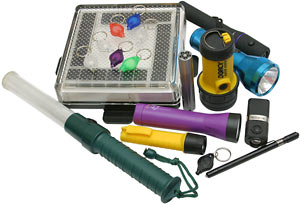
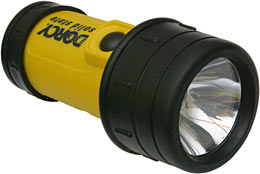
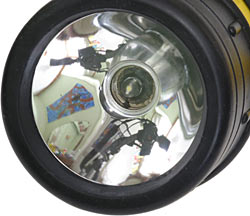
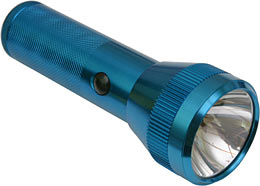
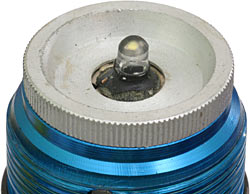

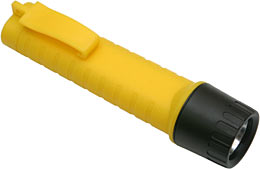


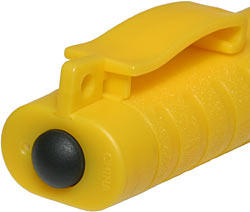

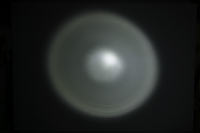
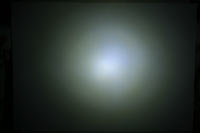
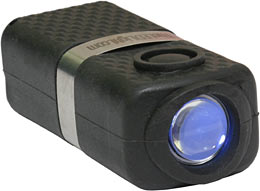
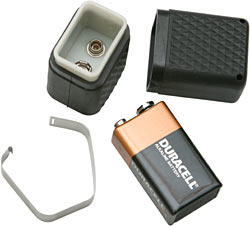
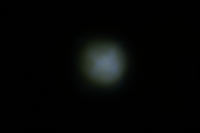

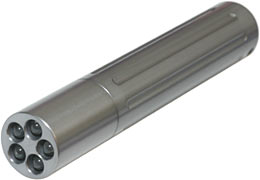
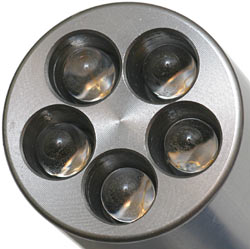
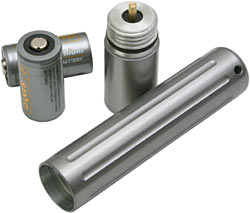


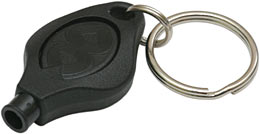
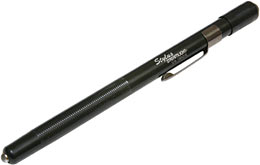
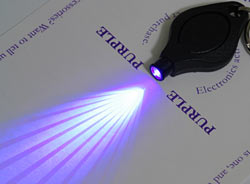


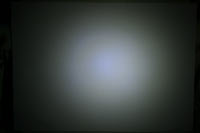





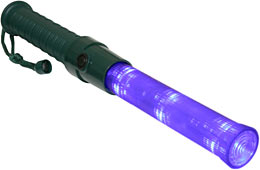
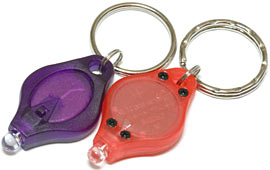
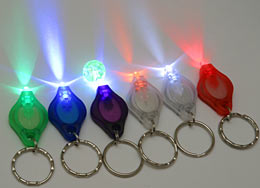


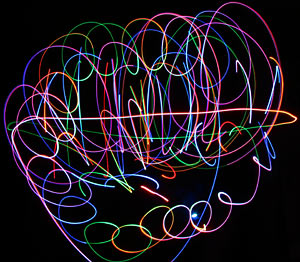

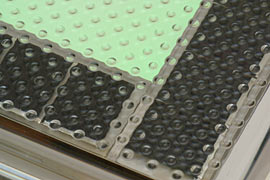
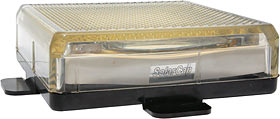

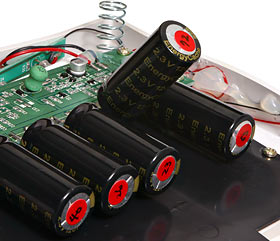



![[SecureWebs]](images/sw.gif)